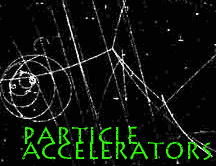Particle Accelerators: At the intersection of science, technology,
and photography
Guest Curator: Jane D. Marsching
“To describe the evolutions in the dance of these gods, their juxtapositions and their advances, to tell which came into line and which in opposition, to describe all this without visual models would be labor spent in vain.” --Plato, Timaeus
“Of all our senses, it is vision that most informs the mind.” --from
Powers of Ten: About the Relative
Size of Things in the Universe
Artists:
Jordan Crandall, NY
Susan Derges, UK
Laura Emrick, NY
Fakeshop, NY
Joan Fontcuberta, Spain
Ken Goldberg, CA
Blainey Kern, New Orleans
Tina LaPorta, NY
David Nyzio, NY
Gary Schneider, NY
Sterck & Rozo, NY
Eugene Thacker, NY
Todd Watts, NY
Wenyon & Gamble, Boston
Gail Wight, CA
Information sciences, life sciences, biotechnology, genetic coding, technoscience,
artificial intelligence, virtual reality, astrophysics, computational sciences,
neural networks, nanotechnology, atomic physics, we are staggering under the
interminable weight of discoveries, inventions, and breakthroughs thanks to
the impermeable alliance of science and technology. It often seems that everything
we hold dear, or perhaps simply everything we learned in high school biology
is being split wide open, redefined, or just plain made into something that
seems like science fiction, like the warp drives of the Star Trek spaceships
or the carlike space vehicles of the Jettsons. The particle
accelerator, popularly called an atom
smasher, is such an image and technology of this astounding technological
age. Extending over several miles underground, it produces beams of energetic
charged particles and directs them against various targets. Needed to observe
objects as small as the atomic nucleus in studies of its structure and of
the forces that hold it together, the particle accelerator is also required
to provide enough energy to create new particles. A kind of high powered version
of our childhood marbles game on the level of atoms, the particle accelerator
is one of many phenomenal marriages of technology and science to produce wondrous
visions of worlds far beyond the capacity of the unaided eye.
Photography owes its life to science; perhaps it might be said that science
could not be where it is without the various technologies of image making
that have increasingly proliferated throughout our century. The scientific
method more often than not depends upon some form of visualization and recording
be it images, diagrams, or charts. Conversely, developments in the science
and technology of image making usually for the purposes of industry or research
continually have opened to artists new modes of image making as medium and
subject. Uneasy blood sisters, these two disciplines have maintained an fragile
truce, and it is often in the work of contemporary artists that this fraught
terrain has been mapped.
The larger portion of scientific and technological advances of the twentieth
century depended heavily upon improvements and innovations in the scientific
instrumentation that enables humans to see beyond the limits of the naked
eye as well as to record those images for further study and as proof of the
phenomena. Many of these images cross the boundary between scientific and
artistic worlds. From Talbot’s
earliest images of moth wings through a microscope to Marey’s
explorations of human locomotion, from Doc
Edgerton’s experiments with high speed photography to the Visible
Human project, scientific image making has been a constant subject for
artists throughout photography’s brief history.
However, art and science have more often been seen as opposing rather than
as aligned. Seeing has been interlinked with technology from the beginning,
but the invention of photographs that could be fixed permanently made it possible
to make temporaneous seeing fixed and permanent. It has not always been clear
that while developments in technology have extended and refined human limitations,
these instruments and their photographs do not escape the profound influence
of acculturation on cognitive processing. The marriage of science and technology
through technologies of observation and image making takes place in the theater
of representation, creating spectacles for our eager consumption. Science
in the public eye has been a compelling drama, with images that not only reveal
new aspects or places of our inner and outer worlds, but which also tell us
what we desire to know and see, where our hopes and fantasies live.
The artists in Particle Accelerators are for the most part concerned with
a poetic reconstruction of the images, events, discoveries, subjects, and
methodologies of science, in altering our actual perception of the scientific
discourse, rather than proving or promoting its hypotheses and theorem. A
varied attention is paid by each artist to the uses and abuses of technology
in giving us data or information about ourselves and our world. All of the
works in the show are unified around the conviction that science is no longer
an objective discipline based on pure ideals and mathematical laws and that
technology is an agency for the encoding of science, for reverie, as well
as for visiting and revisiting our sense of beauty, agency, the self, and
ultimately, the sublime. These artists often also blur the distinctions between
the scientific and the poetic, using diverse technologies as integral elements
in their new constructions and representations. All these artists participate
in the larger cultural process by which the methodologies and modes of inquiry
of science are being investigated and challenged in emerging technological
paradigms.
